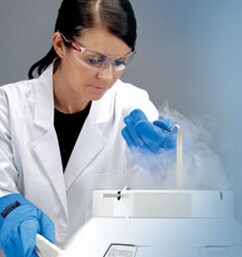 What’s the best cryopreservation methodology for your samples?
What’s the best cryopreservation methodology for your samples?
That’s not an easy question to answer.
Several factors, such as the type and concentration of cryoprotective agent (CPA), cooling rate, plunge temperature (if vitrification is chosen) and warming temperature, can all impact post-thaw recovery.
In addition, it’s well-documented that cryopreservation protocols need to be optimized for different species and cell types – a method that works well for human stem cells might give poor results when preserving mouse embryos, for example.
And now, new research indicates that protocols might have to be even more specific than that.
In a recent issue of CryoBiology, Kashuba and colleagues showed that not only do the CPA concentration, cooling rate and plunge temperature matter for cell types at the species level, but these parameters must also be considered for identical cell types with different genetic backgrounds.
The rationality behind the research is fairly straightforward: Different cell lines can have varying gene expression, which can change cellular features like membrane permeability and therefore post-thaw recovery rates.
The authors first tested mouse embryonic stem cells (mESCs) from four different genetic backgrounds using a standard cryopreservation protocol. They found post-thaw recovery to vary significantly between cell lines, with percent recovery ranging from 10% to 33%. To explain this variation, the authors looked further at the characteristics of each cell line that could have an effect on preservation and recovery. They measured several cellular characteristics, such as cell volume, tolerance to increased and reduced solute concentrations and membrane permeability in the presence of a CPA. Some parameters were found to be significantly different between genetic backgrounds, possibly explaining the range in post-thaw recovery.
In the author’s words, a “one size fits all” approach may not be the best when selecting a cryopreservation protocol. They also show some interesting results with regard to cooling rate and the cryoprotectant (CPA) used.
These results further underscore the importance of making sure the cooling rate you use has been selected only after detailed research. In other words, assuming that a 1°C /min rate of cooling will work for your needs may be putting the samples at undo risk. However, it may be difficult to find reported protocols for a specific cell line. If post-thaw recovery isn’t as high as you would like, modifying the cooling rate, CPA or plunge temperature and testing different values is one route to take.
The original paper, Rationally optimized cryopreservation of multiple mouse embryonic stem cell lines: I–Comparative fundamental cryobiology of multiple mouse embryonic stem cell lines and the implications for embryonic stem cell cryopreservation protocols, is available here. The authors also published a companion paper where they develop theoretical cryopreservation protocols based on the measured cellular characteristics and test them on the different cell lines – interestingly, post-thaw recovery was improved by as much as seven-fold.
Excelent Alex ¡…..thanks